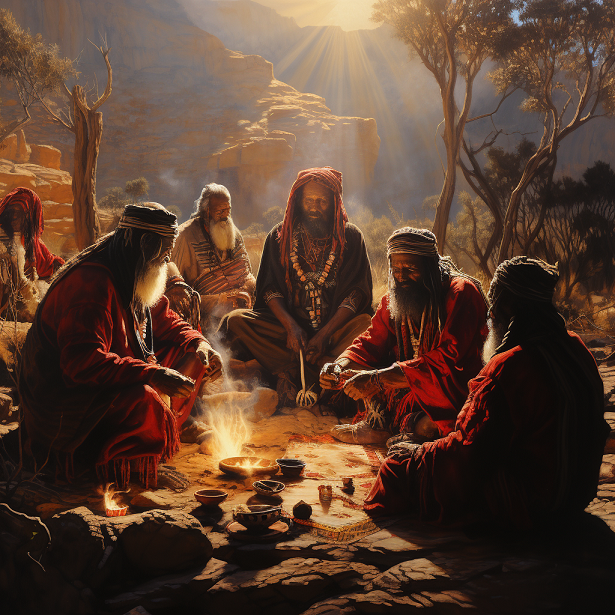In the late 19th century, amidst the rugged terrains and enigmatic landscapes of Arabia, Charles Doughty embarked on a journey that would unravel the mysteries of Central Arabia’s heart. Renowned for his meticulous observations and fearless exploration, Doughty’s odyssey laid the foundation for an in-depth understanding of a region veiled in geological wonders, nomadic rhythms, and urban evolution. This essay delves into a chapter of Doughty’s travels, particularly his encounters with the formidable Kheibar and the intricate tapestry of Central Arabia’s landscapes. As we traverse the paths described in his seminal work, “Travels in Arabia Deserta,” we peel back the layers of time and terrain, examining the symbiotic relationship between nature and human agency that defines the essence of Central Arabia.
Unlocking the Mysteries of Kheibar
Amidst the challenging expanse of the Harrah tract lies Kheibar, a location that holds a pivotal role in the narrative of this formidable terrain. Doughty delves into the heart of Kheibar, providing a lens through which we can unravel the mysteries concealed within its landscape.
Kheibar emerges as a focal point in Doughty’s narrative, intricately connected to the Harrah tract’s unique geological features. Doughty’s descriptive prowess unveils Kheibar’s association with the horrid lava beds, where the land, frozen in time, presents a mesmerising yet treacherous tableau. The sharp shelves, an intricate dance of nature’s forces, demand careful navigation as explorers venture through this challenging terrain.
As we traverse the intricate topography of Kheibar through Doughty’s discerning eyes, the reader is beckoned to appreciate the raw beauty and unforgiving nature of this land. The convergence of geological elements in Kheibar serves as a prelude to the broader exploration of the Harrah tract, where each step unearths a new layer of complexity and awe-inspiring natural phenomena.
Jabal Shammar & Selma
Beyond the expansive Harrah tract and the challenging terrain of Kheibar, our exploration leads us to Jabal Shammar, a region characterised by a dusty steppe, typical of the Arabian landscape. Positioned between the geological wonders to the west and the vastness of the “Belly” to the south, Jabal Shammar reveals a different facet of Arabia’s diverse topography.
In this arid steppe, reminiscent of shifting sands and vast open spaces, the Harb tribesmen roam, their nomadic lifestyle harmonising with the natural rhythm of the land. Waterholes, scattered oases in this desolate expanse, serve as essential waypoints for these nomadic communities, highlighting the delicate balance between survival and the inhospitable environment.
As we traverse further, the settlements in the vicinity of Selma begin to emerge, marking a transition from the transitory to the more permanent. Carlo Guarmani’s keen observations shed light on these communities, surrounded by walls of earth, kneaded and dried in the sun. The dwellings, though not varying significantly from those in Teima, exhibit a certain permanence, providing a glimpse into the resilience of human habitation in this challenging environment.
The settlements, described as vast palm plantations in the plains formed by the encroaching sand, present a stark contrast to the lava-laden landscapes witnessed earlier. Guarmani’s discerning eye captures the essence of these communities, engaged in the ordinary tasks of life, weaving cloth and creating carpets, as they coexist with the natural forces that shape their surroundings.
Hail, positioned almost at the northern mouth of the intramontane plain, becomes a pivotal point where the transient nature of the steppe gives way to more permanent
Emir Muhammad & Urban Dynamics in Hail
As our exploration extends northward, we encounter Hail, a town that commands significance both in geographical terms and as a testament to evolving urban dynamics in the heart of Arabia. Nestled at the northern mouth of the intramontane plain, Hail’s strategic position positions it at the crossroads of Euphratean routes and the Nafiid, creating a hub that has witnessed substantial growth and transformation over time.
Emir Muhammad, a central figure in Hail’s narrative, emerges as a key player in shaping the destiny of this town. His reign, marked by the enlargement of the castle, reflects the changing political landscape in Central Arabia.
The newness and cleanliness of Hail, highlighted by various observers, indicate a departure from the traditional image of Arabian settlements. Hail’s streets exude a liberal air of civilised commerce, setting it apart from the more rugged landscapes encountered in the Harrah tract and the dusty steppe of Jabal Shammar. Palgrave, in particular, offers an insightful depiction of urban society within Hail, emphasising the diversity of Arabian experiences.
Hail’s urban life, portrayed vividly by Palgrave, becomes a focal point of our exploration. His meticulous descriptions, grounded in firsthand observations, delve into private houses, bustling streets, and the court, shedding light on the daily rhythms of life in this evolving town. The contrast between Hail’s urban vibrancy and the nomadic existence in the surrounding steppe adds layers to our understanding of the complexities inherent in Arabian societies.
Wady er-Rumma & Qaseem’s Prosperity
The exploration of Central Arabia would be incomplete without unravelling the significance of Wady er-Rumma, a dry waterway that weaves through the heart of the region, leaving an indelible mark on the landscape and shaping the prosperity of Qaseem. This great channel, stretching over a thousand miles, unfolds as a critical artery of North Arabian drainage, carrying with it the legacy of centuries.

The journey along Wady er-Rumma unveils the intricate relationship between water dynamics and human habitation. Lower Qaseem, nurtured by the perennial presence of water beneath the wady’s bed, stands as a testament to the transformative power of this “dry waterway.” Doughty’s account, enriched by the testimony of other travellers like Huber, sheds light on the infrequency of floods and the remarkable longevity of the last great freshet, a phenomenon that shaped Qaseem’s agricultural landscape.
The agricultural prosperity along Wady er-Rumma finds its zenith in towns like Aneiza and Bereida, where the continuous availability of water facilitates extensive palm groves and wheat fields. The farms, irrigated by the concealed water source, become oases of abundance amidst the arid surroundings. Qaseem emerges not merely as a geographical entity but as a testament to the symbiosis between natural watercourses and human endeavours.
Bereida, strategically positioned within the confines of Wady er-Rumma, becomes a microcosm of the broader geopolitical intricacies. The town’s compliance and astute diplomacy grant it immunity from devastation, showcasing the delicate dance between political realities and local autonomy. The nuanced dynamics of Qaseem’s towns, oscillating between resilience and adaptation, contribute to the rich tapestry of Central Arabia.

